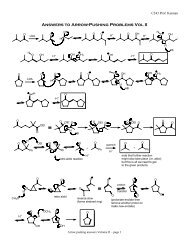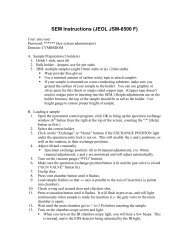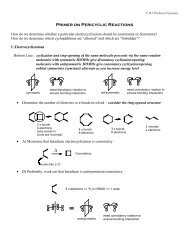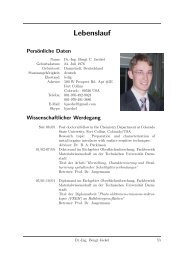Monolayer Behavior of NBD-Labeled Phospholipids at the Air/Water ...
Monolayer Behavior of NBD-Labeled Phospholipids at the Air/Water ...
Monolayer Behavior of NBD-Labeled Phospholipids at the Air/Water ...
- No tags were found...
Create successful ePaper yourself
Turn your PDF publications into a flip-book with our unique Google optimized e-Paper software.
5548 Langmuir, Vol. 18, No. 14, 2002 Tsukanova et al.<br />
Table 1. Fluorescence Anisotropy, r, a and REES Effect<br />
Values b for DPPE-<strong>NBD</strong> and <strong>NBD</strong>(C 12)-PC in <strong>Monolayer</strong>s<br />
<strong>at</strong> Different Molecular Areas<br />
area<br />
(nm 2 /<br />
molecule) r DPPE-<strong>NBD</strong> r <strong>NBD</strong>(C12)-PC<br />
REES DPPE-<strong>NBD</strong><br />
(nm)<br />
REES <strong>NBD</strong>(C12)-PC<br />
(nm)<br />
0.9 0.22 0.003<br />
0.7 0.25 0.003 4<br />
0.6 0.23 0.003 6 2<br />
0.5 0.26 0.003 9 6<br />
0.4 0.27 0.003 14<br />
a Polarized fluorescence was measured using excit<strong>at</strong>ion wavelengths<br />
<strong>of</strong> 465 and 470 nm for DPPE-<strong>NBD</strong> and <strong>NBD</strong>(C 12)-PC,<br />
respectively. b REES values given in <strong>the</strong> table correspond to <strong>the</strong><br />
shift <strong>of</strong> <strong>the</strong> emission maximum <strong>of</strong> DPPE-<strong>NBD</strong> (<strong>NBD</strong>(C 12)-PC) upon<br />
changing <strong>the</strong> excit<strong>at</strong>ion wavelength from 465 nm (470 nm) to 500<br />
nm.<br />
ized vertically and horizontally (s-polarized), respectively.<br />
G is <strong>the</strong> gr<strong>at</strong>ing correction factor, which is <strong>the</strong> r<strong>at</strong>io <strong>of</strong> <strong>the</strong><br />
sensitivities <strong>of</strong> <strong>the</strong> detection system for vertically and<br />
horizontally polarized light given by G ) I sp /I ss . 2,50 For<br />
completely polarized emission r ) 1. 50 However, a value<br />
<strong>of</strong> r equal to unity is never found for <strong>the</strong> chromophores<br />
ei<strong>the</strong>r in vitrified solution or <strong>at</strong> interfaces because <strong>of</strong> a<br />
distribution <strong>of</strong> chromophore orient<strong>at</strong>ions always present<br />
between θ and dθ. Regarding <strong>the</strong> θ distribution, a<br />
maximum value <strong>of</strong> 0.4 should be expected for r when <strong>the</strong><br />
absorption and emission dipoles are collinear, and when<br />
no processes result in depolariz<strong>at</strong>ion. 50<br />
To calcul<strong>at</strong>e fluorescence anisotropy, r, polarized fluorescence<br />
spectra from <strong>the</strong> DPPE-<strong>NBD</strong> monolayer were<br />
measured <strong>at</strong> different areas per molecule. The values <strong>of</strong><br />
r DPPE-<strong>NBD</strong> are presented in Table 1: anisotropy <strong>of</strong> <strong>the</strong> DPPE-<br />
<strong>NBD</strong> fluorescence remains essentially <strong>the</strong> same, varying<br />
between 0.22 and 0.27 with decreasing area per molecule.<br />
This suggests th<strong>at</strong> <strong>the</strong> <strong>NBD</strong> chromophore <strong>of</strong> DPPE-<strong>NBD</strong><br />
adopts a r<strong>at</strong>her narrow distribution <strong>of</strong> orient<strong>at</strong>ions <strong>at</strong> <strong>the</strong><br />
air/w<strong>at</strong>er interface characterized by <strong>the</strong> angle θ th<strong>at</strong><br />
remains almost unchanged during monolayer compression.<br />
As roughly estim<strong>at</strong>ed using eq 6, anisotropy values<br />
<strong>of</strong> 0.22-0.27 correspond to an angle θ <strong>of</strong> 44-46°. In<br />
contrast, almost no anisotropy was observed in <strong>the</strong><br />
fluorescence <strong>of</strong> <strong>the</strong> <strong>NBD</strong>(C 12 )-PC monolayer. Regardless<br />
<strong>of</strong> <strong>the</strong> combin<strong>at</strong>ion <strong>of</strong> excit<strong>at</strong>ion and emission polariz<strong>at</strong>ions,<br />
both I pp and I ps were roughly constant. As a result, eq 7<br />
yielded a value <strong>of</strong> 0.003 for r <strong>NBD</strong>(C12)-PC over <strong>the</strong> range <strong>of</strong><br />
areas per molecule listed in Table 1. The possible causes<br />
for <strong>the</strong> complete loss <strong>of</strong> anisotropy could be th<strong>at</strong> (1)<br />
chromophores are all oriented alike, making an angle <strong>of</strong><br />
54.7° away from <strong>the</strong> surface normal, or, on <strong>the</strong> contrary,<br />
(2) <strong>the</strong> <strong>NBD</strong> chromophore <strong>of</strong> <strong>NBD</strong>(C 12 )-PC does not have<br />
a unique orient<strong>at</strong>ion <strong>at</strong> <strong>the</strong> air/w<strong>at</strong>er interface and more<br />
than one popul<strong>at</strong>ion <strong>of</strong> <strong>NBD</strong> characterized by different<br />
angles θ 50 exists in <strong>the</strong> <strong>NBD</strong>(C 12 )-PC monolayer. It could<br />
also be th<strong>at</strong> depolariz<strong>at</strong>ion associ<strong>at</strong>ed with ei<strong>the</strong>r in-plane<br />
or out-<strong>of</strong>-plane chromophore rot<strong>at</strong>ional motion occurs<br />
during <strong>the</strong> course <strong>of</strong> excit<strong>at</strong>ion. 2,46,50 To identify whe<strong>the</strong>r<br />
any <strong>of</strong> <strong>the</strong> above explan<strong>at</strong>ions is correct, REES measurements<br />
were performed for both <strong>NBD</strong>-phospholipid monolayers.<br />
The fluorescence emission spectra <strong>of</strong> <strong>the</strong> DPPE-<strong>NBD</strong><br />
monolayer presented in Figure 7 were obtained using an<br />
excit<strong>at</strong>ion wavelength <strong>of</strong> 465 nm. With excit<strong>at</strong>ion <strong>at</strong> 465<br />
nm <strong>the</strong> emission maximum occurs within a range <strong>of</strong> 549-<br />
558 nm. Changing <strong>the</strong> excit<strong>at</strong>ion wavelength from 465 to<br />
490 and 500 nm caused a progressive red shift in <strong>the</strong><br />
emission maximum <strong>of</strong> DPPE-<strong>NBD</strong>. Such a dependence <strong>of</strong><br />
<strong>the</strong> emission spectra on <strong>the</strong> excit<strong>at</strong>ion wavelength is<br />
characteristic <strong>of</strong> <strong>the</strong> REES effect. Values <strong>of</strong> REES for <strong>the</strong><br />
DPPE-<strong>NBD</strong> monolayer <strong>at</strong> different areas per molecule<br />
are listed in Table 1: an REES <strong>of</strong> 4 nm was observed<br />
initially <strong>at</strong> an area <strong>of</strong> ∼0.7 nm 2 /molecule corresponding<br />
to <strong>the</strong> onset <strong>of</strong> <strong>the</strong> pl<strong>at</strong>eau <strong>of</strong> <strong>the</strong> DPPE-<strong>NBD</strong> iso<strong>the</strong>rm.<br />
Then, as compression proceeded, <strong>the</strong> REES value increased<br />
gradually and reached a maximum <strong>at</strong> an area <strong>of</strong><br />
0.4 nm 2 /molecule where a change in <strong>the</strong> excit<strong>at</strong>ion<br />
wavelength from 465 to 500 nm resulted in a shift <strong>of</strong> <strong>the</strong><br />
emission band from 558 to 572 nm, equivalent to an REES<br />
<strong>of</strong> 14 nm. This observ<strong>at</strong>ion indic<strong>at</strong>es th<strong>at</strong> <strong>the</strong> <strong>NBD</strong><br />
chromophore <strong>of</strong> DPPE-<strong>NBD</strong> is in a surrounding m<strong>at</strong>rix<br />
where its mobility as well as <strong>the</strong> reorient<strong>at</strong>ional motion<br />
<strong>of</strong> <strong>the</strong> w<strong>at</strong>er dipoles around <strong>the</strong> excited-st<strong>at</strong>e chromophore<br />
is considerably restricted. 2<br />
When compressed to an area <strong>of</strong> 0.6-0.5 nm 2 /molecule,<br />
<strong>the</strong> <strong>NBD</strong>(C 12 )-PC monolayer also exhibited an REES.<br />
However, <strong>the</strong> effect <strong>of</strong> excit<strong>at</strong>ion <strong>at</strong> <strong>the</strong> red edge <strong>of</strong> <strong>the</strong><br />
absorption spectrum on <strong>the</strong> position <strong>of</strong> <strong>the</strong> emission<br />
maximum was less pronounced. Indeed, upon changing<br />
<strong>the</strong> excit<strong>at</strong>ion wavelength from 470 nm, normally used to<br />
obtain <strong>the</strong> fluorescence spectra in Figure 8, to 500 nm, an<br />
REES <strong>of</strong> <strong>the</strong> emission band <strong>of</strong> 6 nm was observed only for<br />
<strong>the</strong> <strong>NBD</strong>(C 12 )-PC monolayer compressed to an area <strong>of</strong> 0.5<br />
nm 2 /molecule. The REES <strong>of</strong> 2-6 nm (Table 1) detected <strong>at</strong><br />
<strong>the</strong> end <strong>of</strong> <strong>the</strong> π-A iso<strong>the</strong>rm suggests th<strong>at</strong> for a large<br />
range <strong>of</strong> molecular areas <strong>the</strong> immedi<strong>at</strong>e environment <strong>of</strong><br />
<strong>the</strong> <strong>NBD</strong> chromophore <strong>of</strong> <strong>NBD</strong>(C 12 )-PC is <strong>the</strong> aqueous<br />
phase adjacent to <strong>the</strong> headgroup region where <strong>the</strong><br />
relax<strong>at</strong>ion <strong>of</strong> w<strong>at</strong>er molecules is extremely fast. 2 This<br />
explains why no REES effect was observed <strong>at</strong> areas above<br />
0.6 nm 2 /molecule. These findings are in good accord with<br />
<strong>the</strong> polarized fluorescence measurements and provide<br />
fur<strong>the</strong>r evidence th<strong>at</strong> looping <strong>of</strong> <strong>the</strong> <strong>NBD</strong>-labeled acyl chain<br />
projects <strong>the</strong> <strong>NBD</strong> group <strong>of</strong> <strong>NBD</strong>(C 12 )-PC deeper into <strong>the</strong><br />
w<strong>at</strong>er subphase where <strong>the</strong> rot<strong>at</strong>ion motions <strong>of</strong> <strong>the</strong> chromophore<br />
and surrounding w<strong>at</strong>er dipoles are not restricted<br />
to any significant extent by steric hindrance. In contrast,<br />
DPPE-<strong>NBD</strong> molecules are organized in condensed structures<br />
represented by <strong>the</strong> nonfluorescent rosette-shaped<br />
domains seen in Figure 3B in which <strong>the</strong> inherent photophysical<br />
properties <strong>of</strong> <strong>NBD</strong> are altered by interactions<br />
<strong>of</strong> chromophores with one ano<strong>the</strong>r and/or with phospholipid<br />
headgroups.<br />
3.5. Structural Ordering <strong>of</strong> <strong>the</strong> <strong>NBD</strong>-<strong>Phospholipids</strong><br />
in <strong>Monolayer</strong>s. As mentioned in section 3.2 above,<br />
an interesting fe<strong>at</strong>ure <strong>of</strong> <strong>the</strong> DPPE-<strong>NBD</strong> monolayer<br />
behavior is <strong>the</strong> double-layer ψ 0 potential whose dependence<br />
on <strong>the</strong> area per molecule devi<strong>at</strong>es significantly from<br />
th<strong>at</strong> predicted by <strong>the</strong> Gouy-Chapman <strong>the</strong>ory. Instead <strong>of</strong><br />
continuous growth <strong>of</strong> its neg<strong>at</strong>ive value with increasing<br />
surface density <strong>of</strong> neg<strong>at</strong>ively charged phospholipid molecules,<br />
18,51,52 <strong>the</strong> ψ 0 potential exhibits r<strong>at</strong>her unexpected<br />
vari<strong>at</strong>ions throughout monolayer compression. Figure 5B<br />
shows th<strong>at</strong> even though <strong>the</strong> ψ 0 potential does become more<br />
and more neg<strong>at</strong>ive in <strong>the</strong> expanded region as <strong>the</strong> surface<br />
density <strong>of</strong> PE - -<strong>NBD</strong> groups is increased (with decreasing<br />
area per molecule upon compression), <strong>the</strong> absolute value<br />
<strong>of</strong> ψ 0 starts to decrease upon onset <strong>of</strong> <strong>the</strong> π-A iso<strong>the</strong>rm<br />
pl<strong>at</strong>eau. This is clear evidence <strong>of</strong> a process which ei<strong>the</strong>r<br />
affects headgroup dissoci<strong>at</strong>ion or induces structural<br />
reorganiz<strong>at</strong>ion in <strong>the</strong> monolayer. As a result, <strong>the</strong> surface<br />
charge density <strong>at</strong> <strong>the</strong> air/w<strong>at</strong>er interface is altered so th<strong>at</strong><br />
<strong>the</strong> monolayer bears almost no charge in <strong>the</strong> condensed<br />
region (<strong>the</strong> ψ 0 potential in Figure 5B drops from ∼-350<br />
mV <strong>at</strong> an area <strong>of</strong> 0.8 nm 2 /molecule to approxim<strong>at</strong>ely -50<br />
(51) Taylor, D. M.; Oliveira, O. N., Jr.; Morgan, H. Chem. Phys. Lett.<br />
1989, 161, 147.<br />
(52) Aguilella, V. M.; Mafé, S.; Manzanares, J. A. Chem. Phys. Lipids<br />
2000, 105, 225.











